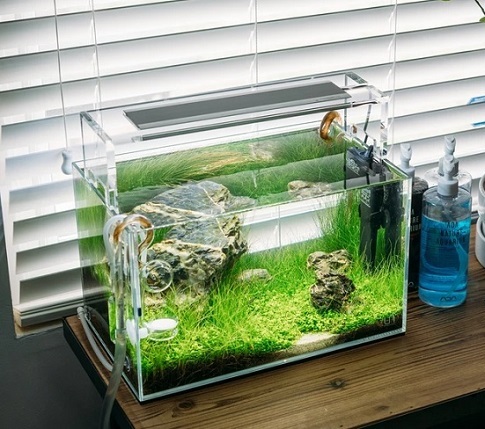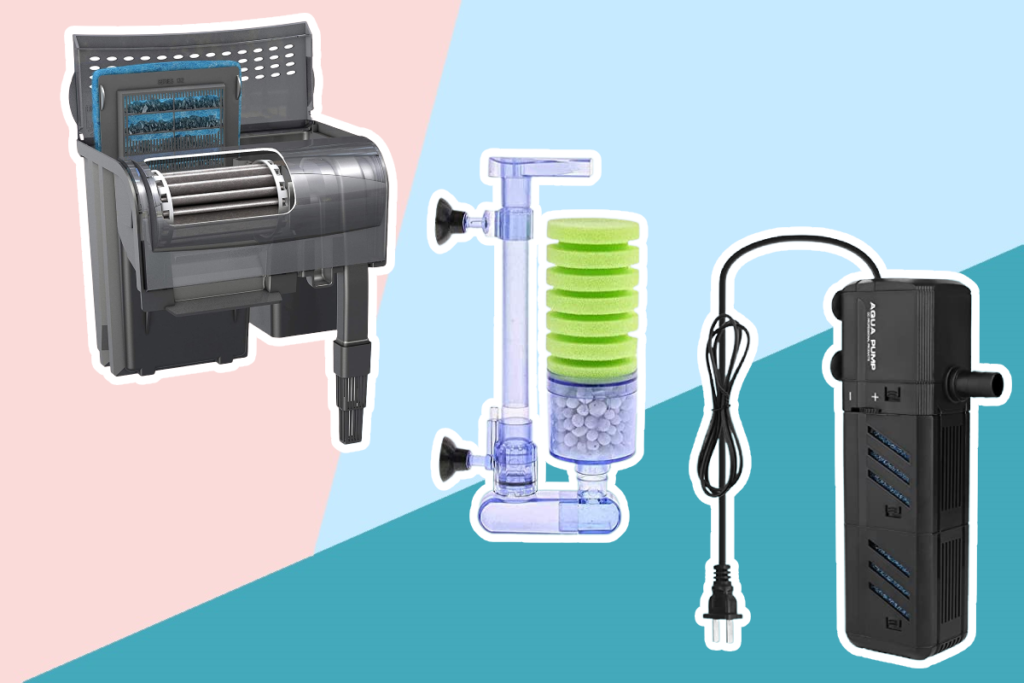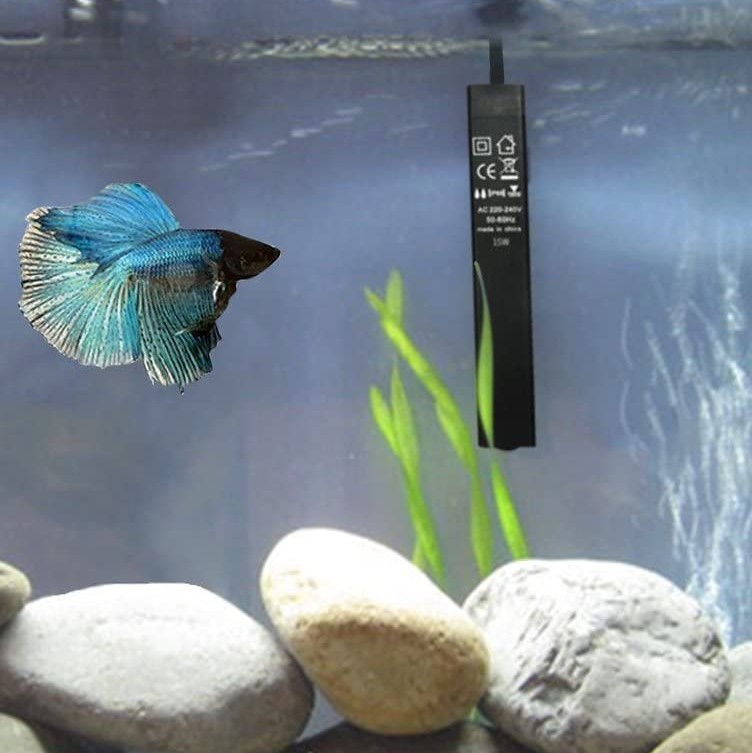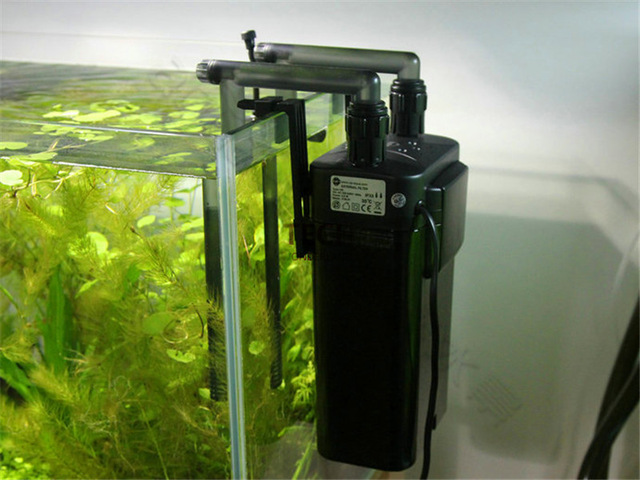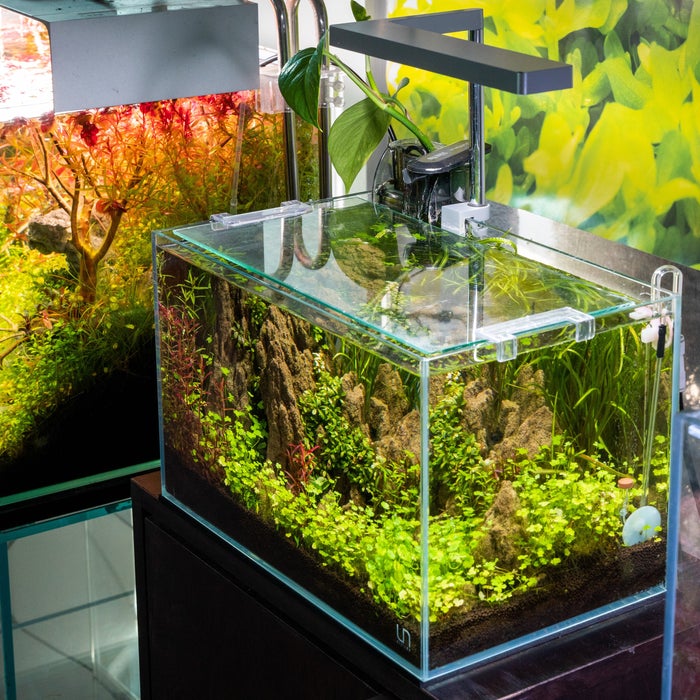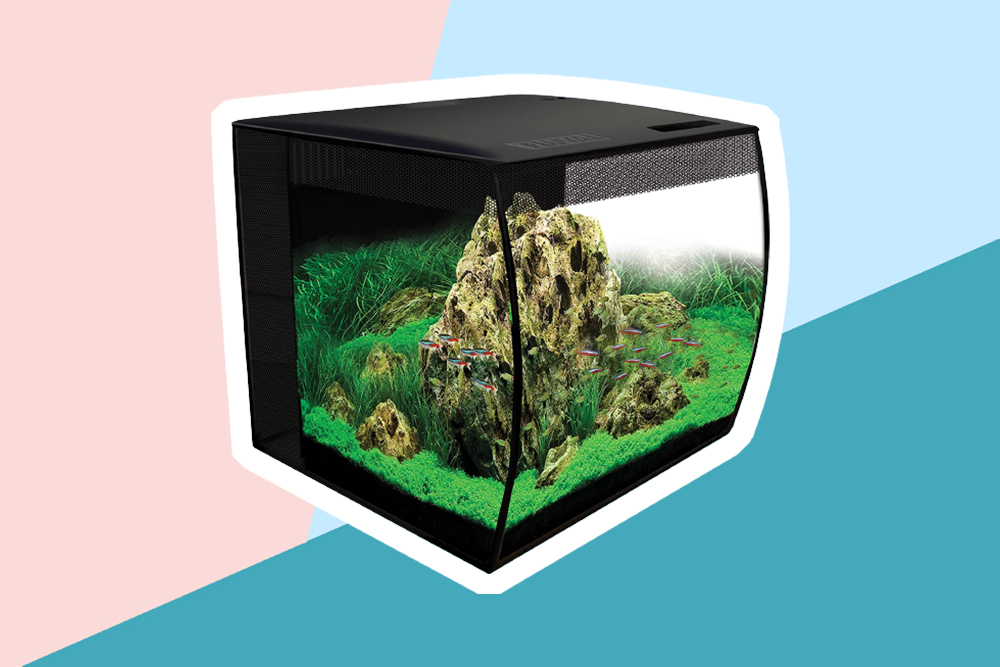

If you’re looking for an easy and affordable way to keep your aquarium clean, a sponge filter may be the solution for you.
When choosing the best sponge filter, it’s important to consider the size of your aquarium and the amount of debris it produces. Be sure to get a filter with a sponge that is large enough to trap all that debris. You’ll also want a filter that is easy to use and maintain so that you don’t have to spend a lot of time cleaning it. There are many different brands of sponge filters available, so it can be difficult to know which one is right for you. That’s why we’ve compiled a list of the seven best sponge filters available. Let’s dive in!
Other features: two filter media containers, telescopic air water outlet tube; comes with two strong suction cups and a bag of ceramic media balls
The Hygger Aquarium Double Sponge Filter is our Editor’s Choice for the best sponge filter. This is a great choice for those looking for an easy and affordable way to keep their aquarium clean. It comes with a bag of ceramic media balls and two filter media containers, as well as a telescopic air-water outlet tube. We found that it is very easy to install and can be run by most air pumps larger than 4W. This filter is a great choice for both freshwater and saltwater tanks.
The Hygger double sponge filter compares favorably to other top-tier sponge filters like Hikari Bacto-Surge High density foam filter. It is the better option if you need a filter with multi-filtration functions that can add tons of biological filtration to your fish tank. Its quiet operation also sets it apart.
Other features: hooks up directly to a powerhead or pump, 1″ diameter lift tubes
The Aquarium Technology Hydro-Sponge III Filter is a high-quality filter designed for tanks up to 40 gallons. This is a great option for those in need of high flow filtration for their freshwater or saltwater aquariums. This filter has 1″ diameter lift tubes and a raised sponge that removes dead space below the filter, which connects directly to a powerhead or pump. This makes it an ideal option for those with smaller tanks, as it takes up less space and provides more efficient filtration.
The Aquarium Technology Hydro-Sponge III filter also stacks up well against other premium quality sponge filters like Hikari Bacto-Surge high density foam filter due to its superior quality build. We think this filter is a much better option than the Hygger double sponge filter when it comes to quiet operation because you can modify it to make it more silent.
Other features: high-quality suction cups, adjustable length of pipe, dual filter media containers
The Generic Qanvee QS100A Bio Sponge Filter is a great option for those looking for a reliable and affordable sponge filter. This filter is designed for tanks up to 15 gallons in size, making it perfect for use with a variety of different fish and aquatic creatures. Additionally, the filter comes with an optimized outlet piping design that allows for greater air output and lower noise levels. The components of the filter are also made from high-quality food-grade plastic, making them safe and non-toxic for fish and other aquatic creatures. Finally, the filter also comes with a set of high-quality suction cups that makes it easy to install and use.
The Generic Qanvee QS100A Bio Sponge Filter is pretty similar to its brothers Qanvee QS200A, and Qanvee QS200. The only difference between them is filter media capacity. The QS100A can only hold 100g of filter media while the QS200A can hold 200g. The QS200 has a basic mechanical filter that doesn’t have media placement.
Other features: double sponge design, replaceable filter media, available in green color
If you are looking for an effective and efficient sponge filter for your 55-gallon aquarium, then the UPETTOOLS Aquarium Biochemical Sponge Filter is a great option to consider. This sponge filter features a 7-layer ribbing design that provides optimal biochemical filtration to help improve water quality and dissolved oxygen levels in your tank. Additionally, the filter media is replaceable, so you can always keep your tank clean and healthy. The high-quality materials and 360-degree rotation oxygen port make this filter easy to set up and use, and it comes with everything you need to get started, including two suctions, ceramic media balls, and four spare sponges.
The UPETTOOLS Aquarium Biochemical Sponge Filter is very similar to the Hygger double sponge filter. The only difference is that it comes with one sponge instead of two. Both filters are suitable for 10-gallon fish tanks but if you have a taller tank, choose the UPPTTOOLS filter. Its spout, through which bubbles escape is much higher than the one on the Hygger filter.
Other features: works for freshwater and saltwater aquariums, highly porous sponge
Hikari Bacto-Surge Foam Filter XL is ideal for tanks up to 125 gallons in size. It can be used well in both freshwater or marine aquariums and has a highly porous sponge that is easy to clean. The soft sponge material also makes it a great choice for those with sensitive fish or other aquatic animals.
The Hikari Bacto-Surge Foam Filter XL is a top tier sponge filter that compares well with premium choices like the Hygger double sponge filter and the Aquarium Technology Hydro Sponge III filter. We liked that it offers better value for money than the two, plus, it is a better option if you need a compact sponge filter.
Other features: safe for fish, fits standard 3/16″ air tube
If you’re looking for an affordable and easy-to-use corner fish tank filter, the AQUANEAT Corner Fish Tank Filter is a great option. This filter is designed to work with tanks up to 10 gallons in size, and it’s easy to set up and clean. Plus, the air infusion chamber helps to produce minute bubbles which increase the oxygen solubility in the water.
The AQUANEAT Corner Fish Tank Filter is just like the Hikari Bacto-surge filter above in terms of size. It is the best compact filter for small fish tanks on this list because it occupies very little space in the tank. You don’t want to crowd your small fish tank with a large filter.
Other features: 60ppi fine sponge, 2pcs 10-layer ribbing sponges, 360-degree adjustable, comes with 2 suction cups
The Huijukon Double Bio Sponge Filter is a great option for tanks from 15 to 45 gallons. It provides bio filtration, physical filtration, oxygenation, and aeration. The filter is also super quiet and easy to use. It comes with 10-layer ribbing sponges and a 360-degree adjustable water-outlet. We found two suction cups for mounting in the package as well.
Just like the Hygger double sponge filter, the Huijukon Double Bio Sponge Filter has two sponges. They share so much in common including tank capacity. For durability, go for Hygger but for ease of use the Huijukon Double Bio Sponge Filter is your best bet. It does not need any air stone and is easy to clean as all its parts can come apart.
A sponge filter is a type of aquarium filter that uses a porous sponge to trap dirt and other waste. The sponge works as a mechanical filter, trapping larger pieces of waste like uneaten food and fish feces. The sponge also provides a surface for beneficial bacteria to grow, which helps to break down waste and keep the tank water clean.
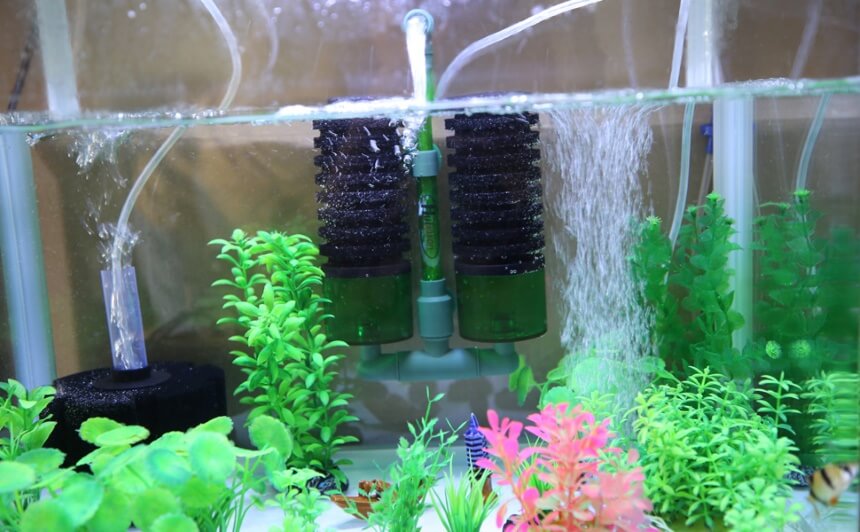
Sponge filters draw water in through the sponge, where the debris and waste are trapped. The water is then expelled from the filter, clean, and ready to be returned to the tank.
The foam sponge is the part of the filter that traps debris and waste. It should be replaced regularly to keep the filter working effectively.
The weighted base helps to keep the sponge filter in place and prevents it from being pulled into the water flow.
The strainer and bull’s eye help to keep the sponge filter clean and prevent debris from clogging the pores. To regulate the water flow and bubbles, many people put an air stone on the bull’s eye.
Air stones are often used in conjunction with sponge filters. Air stones help to oxygenate the water, which is necessary for the beneficial bacteria to grow. They also create a bubbling effect that can be pleasing to look at.
The lift tube allows you to adjust the water flow and control the amount of bubbles that are produced. A quiet output is another benefit of using a high-quality lift tube.
The air pump provides the power for the filter, drawing water in and pushing it out.
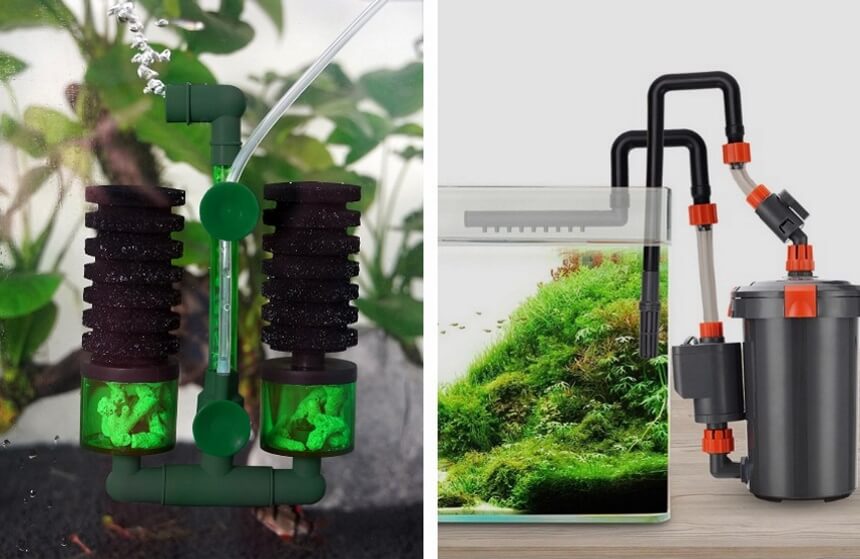
There are two main types of sponge filters: internal and external. Internal sponge filters are designed to be placed inside the aquarium, while external sponge filters are placed outside the tank.
Internal sponge filters are the most common type of sponge filter. They are easy to set up and can be used in a variety of tank sizes. Most internal sponge filters come with suction cups that attach to the side of the tank. These filters also usually have an air stone or other aeration device that helps to keep the water oxygenated. If this is the type of filters you are most interested in, check out our list of the best internal aquarium filters.
External sponge filters are less common than internal sponge filters, but they offer some benefits that internal filters do not. External sponge filters are typically larger and more powerful than internal filters, making them a good choice for larger tanks. They also have the added benefit of being easy to clean. All you need to do is remove the sponge from the filter and rinse it under running water.
There are many benefits to using sponge filters in your aquarium. Sponge filters are:
One of the biggest benefits of sponge filters is that they offer both biological and mechanical filtration. The sponge traps waste and debris, while the beneficial bacteria that grow on the surface of the sponge break down waste and keep the water clean.
Sponge filters also aerate the water, which is necessary for the beneficial bacteria to grow. They also create a bubbling effect that can be pleasing to look at.
Sponge filters are very easy to set up. All you need to do is attach the filter to an air pump and place it in your aquarium. Most sponge filters come with suction cups that make it easy to attach the filter to the side of the tank.
Sponge filters are very affordable, making them a great choice for budget-conscious aquarists.
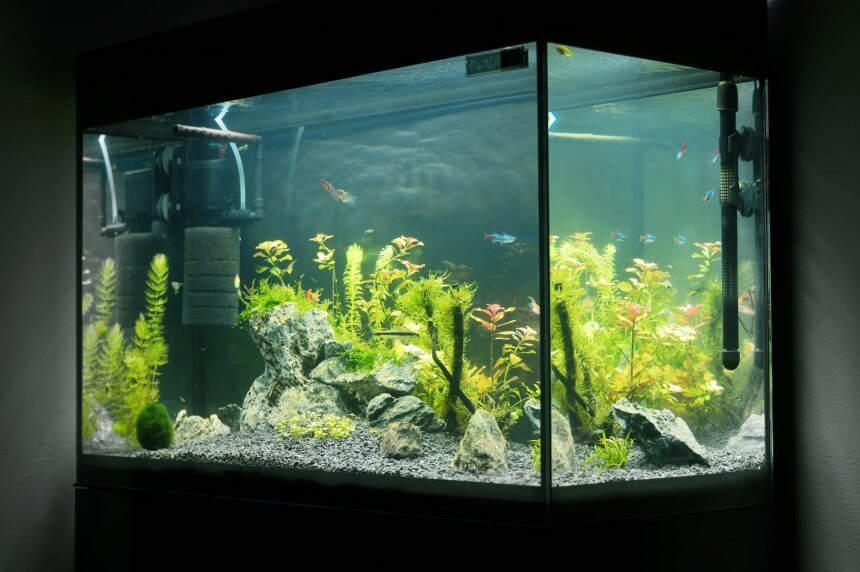
Sponge filters can be used in both small and large tanks. Internal sponge filters are the most common type of filter, and they can be used in a variety of tank sizes. External sponge filters are typically larger and more powerful, making them a good choice for larger tanks.
Another benefit of sponge filters is that they help to prevent overfeeding the fish. The sponge traps uneaten food and waste, which can otherwise pollute the water.
Sponge filters are perfect for small aquariums. They are easy to set up and don’t take up a lot of space. Sponge filters also help to keep the water clean and oxygenated, making them a great choice for small tanks.
Sponge filters are also easy to clean. All you need to do is remove the sponge from the filter and rinse it under running water.
There are a few drawbacks to using sponge filters in your aquarium. Sponge filters:
Sponge filters can clog easily if they are not cleaned regularly. The sponge traps waste and debris, which can quickly build up and cause the filter to stop working.
While sponge filters do a good job of removing waste and debris, they will not remove all of the waste from your aquarium. Some waste will still remain in the water, so it’s important to do regular water changes to keep the water clean.
Sponge filters do not offer chemical filtration, so they cannot remove pollutants from the water. If you are using a sponge filter in a tank that contains fish or other aquatic animals that produce toxins, you will need to use a filter that can remove these toxins from the water.
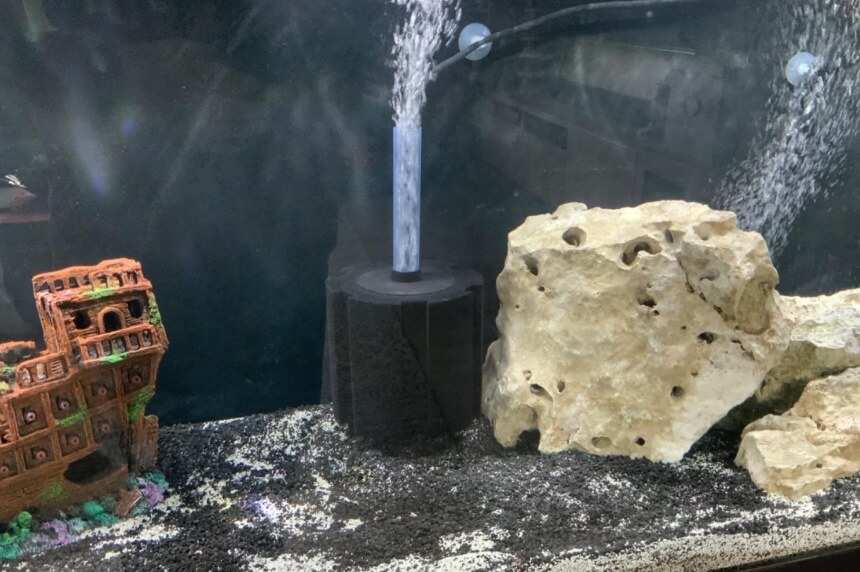
Sponge filters require an air pump to operate. Air pumps are relatively inexpensive, but they can be noisy.
While sponge filters are effective at keeping your aquarium clean, they are not the most attractive option. If you are looking for a filter that will also add to the aesthetic of your aquarium, you may want to consider another type of filter.
Another downside to using sponge filters is that some fish may try to eat the sponge. If you have fish that are prone to eating things they shouldn’t, you may want to consider another type of filter.
Choosing the best sponge filter is not an easy task because there are a lot of products on the market with different features. Here are some things you should consider before making your purchase:
Sponge filters are available in a variety of sizes, so make sure to choose one that is appropriate for your tank size. Most sponge filters are designed for tanks up to 40 gallons, but there are some models that are designed for larger tanks. You might also want to take a look at our reviews of the best aquarium filters for large tanks that include other types of filters.
Sponge filters can be used in both fresh water and saltwater aquariums. However, some sponge filters are specifically designed for use in freshwater tanks, while others are designed for saltwater tanks.
Sponge filters come with a variety of filter media options, so you can choose the one that best suits your needs. Common filter media options include activated carbon, biological balls, and zeolite. You can find more information about that in our article on the best aquarium filter media.
Some sponge filters are easier to install than others. Some models come with suction cups that can be attached to the side of the tank, while others need to be inserted into a power filter.
You should also consider how often you need to clean the sponge filter. Some models need to be cleaned every week, while others can go for a month without needing to be cleaned.
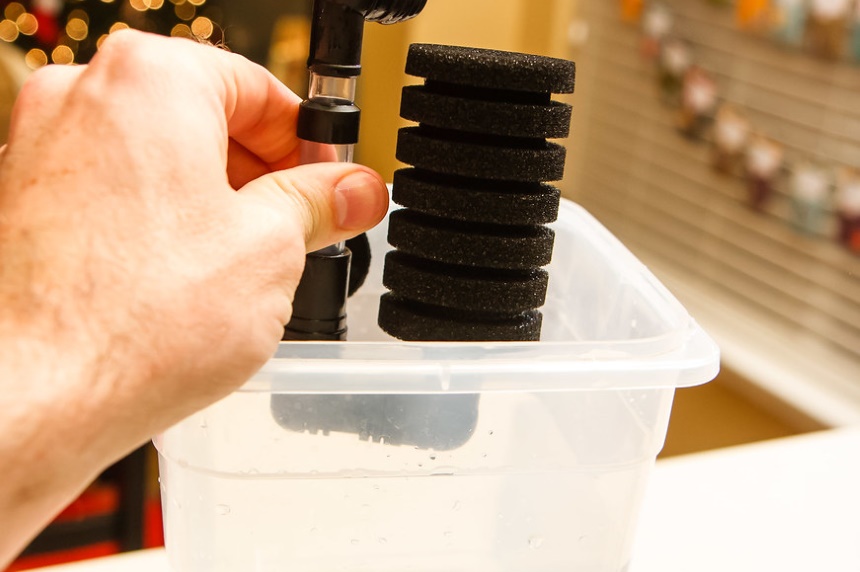
When choosing a sponge filter, it’s important to find one that is easy to clean. Some models come with removable sponges that can be rinsed under running water, while others require disassembly for cleaning.
Sponge filters can be relatively noisy, so it’s important to find one that is designed to operate quietly. Some models come with an air pump silencer to reduce noise, while others have a self-priming feature that eliminates the need for an air pump.
Sponge filters are available in a variety of designs, so you can choose the one that best fits your aquarium’s décor. Some models are designed to be hidden behind plants or rocks, while others are meant to be displayed prominently in the tank.
Sponge filters are usually made from synthetic materials, such as polyurethane or acrylic. Some models are also made from natural materials, such as wool or cellulose.
Sponge filters typically come with a one-year warranty. However, some manufacturers offer extended warranties for an additional cost.
Sponge filters are relatively inexpensive, making them a good choice for budget-conscious aquarium owners.
Maintaining a sponge filter is easy and only requires a few minutes each week. Here are the steps you need to take:
Setting up a sponge filter you need to:
Sponge filters are affordable and easy-to-maintain. They are available in a variety of designs and sizes, so you can find one to fit your needs.
Our Editor’s Choice, the Hygger Aquarium double sponge filter is a powerful filter designed for up to 40-gallon tanks. It comes with everything you need to get started and its telescopic air-water outlet tube helps to customize the water flow and provide better oxygenation.
Our second pick for the best sponge filters is the Aquarium Technology Hydro-Sponge III, which features a raised bottom and a heavier base for better immersion. This is an efficient filter for 20-gallon tanks with a patented sponge foam that catches all the debris.
Finally, our third pick, the Generic Qanvee QS100A bio sponge filter, offers excellent mechanical and biological filtration capabilities. It’s designed for tanks up to 15 gallons in size and comes with an optimized outlet piping design that allows for greater air output and lower noise levels.
